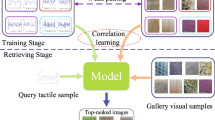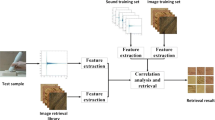Abstract
Visual, haptic, and auditory modalities can provide different properties about surface materials and therefore form important perception methods for common material. Nevertheless, how to effectively combine various modalities is an extremely challenging problem. To this end, the active multi-modal framework based on extreme learning machine with multi-scale local receptive fields is developed to fuse the information of different modalities. We conduct multi-modal experiments on the TUM haptic texture database. The experimental results show the highly representative characteristics can be extracted from surface material by the proposed architecture and the three modalities fusion achieves the best performance. The proposed active multi-modal fusion framework shows significant performance improvements.










Similar content being viewed by others
References
Ojala T, Pietikainen M, Maenpaa T. Multiresolution gray-scale and rotation invariant texture classification with local binary patterns[J]. IEEE Trans Pattern Anal Mach Intell 2002;24(7):971–987.
Guo Z, Zhang L, Zhang D. Rotation invariant texture classification using LBP variance (LBPV) with global matching. Pattern Recogn 2010;43(3):706–719.
Soh LK, Tsatsoulis C. Texture analysis of SAR sea ice imagery using gray level co-occurrence matrices[J]. IEEE Trans Geosci Remote Sens 1999;37(2):780–795.
Ruiz L, Fdez-Sarrła A, Recio J. Texture feature extraction for classification of remote sensing data using wavelet decomposition: a comparative study. ISPRS Congress part B 2004;35:1109–1114.
Kim SC, Kang TJ. Texture classification and segmentation using wavelet packet frame and Gaussian mixture model[J]. Pattern Recogn 2007;40(4):1207–1221.
Huang J, Yu ZL, Cai Z, et al. Extreme learning machine with multi-scale local receptive fields for texture classification[J]. Multidim Syst Sign Process. 2016;1–17.
Zheng H, Fang L, Ji M, et al. Deep learning for surface material classification using haptic and visual information[J]. IEEE Trans Multimed 2016;18(12):2407–2416.
Strese M, Schuwerk C, Iepure A, et al. 2017. Multimodal feature-based surface material classification[J]. IEEE Transactions on Haptics.
Corradi T, Hall P, Iravani P. Object recognition combining vision and touch[J]. Robot Biomimet 2017;4 (1):2.
Cao J, Lin Z. 2015. Extreme learning machines on high dimensional and large data applications: a survey. Mathematical Problems in Engineering.
Mayol-Cuevas W u W, Juarez-Guerrero J, Munoz-Gutierrez S. A first approach to tactile texture recognition[C]//. In: 1998 IEEE International Conference on Systems, Man, and Cybernetics, 1998. IEEE; 1998. vol 5, p. 4246–4250.
Cao J, Lin Z, Huang GB, et al. Voting based extreme learning machine. Inform Sci 2012;185(1):66–77.
Cao J, Wang W, Wang J, et al. 2016. Excavation equipment recognition based on novel acoustic statistical features. IEEE Transactions on Cybernetics.
Cao K et al. Classification of uncertain data streams based on extreme learning machine. Cogn Comput 2015; 7(1):150C60.
Liu H, Yu Y, Sun F, et al. Visual-tactile fusion for object recognition[J]. IEEE Trans Autom Sci Eng 2017;14(2):996–1008.
Tang Q, Shen Y, Hu C, et al. Swarm intelligence: based cooperation optimization of multi-modal functions[J]. Cogn Comput 2013;5(1):48–55.
Liu H, Wu Y, Sun F, et al. Weakly paired multimodal fusion for object recognition[J]. IEEE Trans Autom Sci Eng 2018;15(2):784–795.
Liu H, Sun F, Fang B, et al. Multimodal measurements fusion for surface material categorization[J]. IEEE Trans Instrum Measur 2018;67(2):246–256.
Liu Y, Zhang L, Deng P, et al. Common subspace learning via cross-domain extreme learning machine[J]. Cogn Comput 2017;9(3):1–9.
Liu N, Sakamoto JT, Cao J, et al. Ensemble-based risk scoring with extreme learning machine for prediction of adverse cardiac events[J]. Cogn Comput 2017;9(1):1–10.
Huang GB, Bai Z, Kasun LLC, et al. Local receptive fields based extreme learning machine[J]. IEEE Comput Intell Mag 2015;10(2):18–29.
Huang GB, Zhou H, Ding X, Zhang R. Extreme learning machine for regression and multiclass classification. Syst Man Cybern Part B: Cybern IEEE Trans 2012;42(2):513C29.
Yang Y, Wu QMJ. Multilayer extreme learning machine with subnetwork nodes for representation learning. IEEE Trans Cybern 2016;46(11):2570–2583.
Wen G, Hou Z, Li H, et al. Ensemble of deep neural networks with probability-based fusion for facial expression recognition[J]. Cogn Comput. 2017;1–14.
Liu N, Sakamoto JT, Cao J, et al. Ensemble-based risk scoring with extreme learning machine for prediction of adverse cardiac events[J]. Cogn Comput. 2017;1–10.
Liu Y, Zhang L, Deng P, et al. Common subspace learning via cross-domain extreme learning machine[J]. Cogn Comput. 2017;1–9.
Kim J, Shin HS, Shin K, Lee M. Robust algorithm for arrhythmia classification in ECG using extreme learning machine. Biomed Eng Online 2009;8:31:1C12.
Menelas B, Hu Y, Lahamy H, et al. Haptic and gesture-based interactions for manipulating geological datasets[C]. In: IEEE International conference on systems, man, and cybernetics. IEEE;2011. p. 2051–2055.
Vicente A, Liu J, Yang GZ. Surface classification based on vibration on omni-wheel mobile base. In: Proc. IEEE/RSJ Int. Conf. Intell. Robots Syst. (IROS), 2015;916C921.
Murty KSR, Yegnanarayana B. Combining evidence from residual phase and MFCC features for speaker recognition[J]. IEEE Signal Process Lett 2006;13(1):52–55.
Owren MJ, Bernacki RH. Applying linear predictive coding (LPC) to frequency-spectrum analysis of animal acoustic signals[M] Animal acoustic communication. Berlin: Springer; 1998, pp. 129–162.
Muda L, Begam M, Elamvazuthi I. Voice recognition algorithms using mel frequency cepstral coefficient (MFCC) and dynamic time warping (DTW) techniques[J]. arXiv. 2010;1003–4083.
He W, Guan H, Zhang J. Multimodal object recognition from visual and audio sequences. In: 2015 IEEE International Conference on multisensor fusion and integration for intelligent systems (MFI). IEEE;2015. p. 133–138.
Huang GB, Zhu QY, Siew CK. Extreme learning machine: theory and applications [J]. Neurocomputing 2006;70(1):489–501.
Rumelhart DE, Hinton GE, Williams RJ. Learning representations by back-propagation errors. Nature 1986;323:533–536.
Lv Q, Niu X, Dou Y, et al. Classification of hyperspectral remote sensing image using hierarchical local-receptive-field-based extreme learning machine [J]. IEEE Geosci Remote Sens Lett 2016;13(3):434–438.
Li F, Liu H, Xu X. Multi-modal local receptive field extreme learning machine for object recognition[C]. In: 2016 International Joint conference on neural networks (IJCNN). IEEE;2016. pp. 1696–1701.
Xie SJ, Yoon S, Yang J, et al. Feature component-based extreme learning machines for finger vein recognition[J]. Cogn Comput 2014;6(3):446–461.
Chacko BP, Krishnan VRV, Raju G, et al. Handwritten character recognition using wavelet energy and extreme learning machine[J]. Int J Mach Learn Cybern 2012;3(2):149–161.
Fu A, Dong C, Wang L. An experimental study on stability and generalization of extreme learning machines[J]. Int J Mach Learn Cybern 2015;6(1):129–135.
Balasundaram S, Gupta D. On optimization based extreme learning machine in primal for regression and classification by functional iterative method[J]. Int J Mach Learn Cybern 2016;7(5):707–728.
Sachnev V, Ramasamy S, Sundaram S, et al. A cognitive ensemble of extreme learning machines for steganalysis based on risk-sensitive hinge loss function[J]. Cogn Comput 2015;7(1):103–110.
Landin N, Romano JM, McMahan W, Kuchenbecker KJ. Dimensional reduction of high-frequency accelerations for haptic rendering. Haptics Generating and Perceiving Tangible Sensations. Berlin: Springer; 2010. p. 79–86.
Charles JF. A tutorial on spectral sound processing using Max/MSP and Jitter[J]. Comput Music J 2008;32 (3):87–102.
Serra X, Smith J. Spectral modeling synthesis: a sound analysis/synthesis system based on a deterministic plus stochastic decomposition[J]. Comput Music J 1990;14(4):12–24.
Funding
This work was supported in part by the National Natural Science Foundation of China under Grant U1613212 and Grant 61673238 and in part by the National High-Tech Research and Development Plan under Grant 2015AA042306.
Author information
Authors and Affiliations
Corresponding author
Ethics declarations
Conflict of interest
The authors declare that they have no conflict of interest.
Ethical Approval
This article does not contain any studies with human participants or animals performed by any of the authors.
Informed Consent
Informed consent was obtained from all individual participants included in the study.
Rights and permissions
About this article
Cite this article
Liu, H., Fang, J., Xu, X. et al. Surface Material Recognition Using Active Multi-modal Extreme Learning Machine. Cogn Comput 10, 937–950 (2018). https://doi.org/10.1007/s12559-018-9571-z
Received:
Accepted:
Published:
Issue Date:
DOI: https://doi.org/10.1007/s12559-018-9571-z




